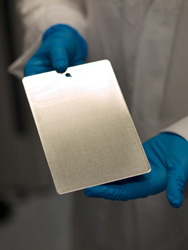Novel photocatalytic coating technologies
Semiconductor photocatalytic (SCP) films have paved the way for new 'green' technologies. Applications include self-cleaning windows, photovoltaics, sterile surfaces, air purification and the elimination of organic contaminants. Such innovations result in a higher quality of life and improved health and safety for European citizens. A decrease in the need for cleaning chemicals, reduced emissions and reduced energy use all have a beneficial impact on the environment. Although SCP materials and processes represent a major new technology, wider application has been hampered by the absence of suitable materials and coating technologies. The PHOTOCOAT project has developed innovative large volume coating technologies with enormous potential. Researchers produced a set of protocols for assessing the photocatalytic activity of largely titania-based SCP materials in the form of clear and opaque films and powders. Existing ink technologies were used to create inks suitable for detecting the activities of photocatalytic materials. The standard photocatalyst assessment methods developed and the range of intelligent inks produced have been invaluable to manufacturers, customers and legislators. The PHOTOCOAT research team also developed a new measurement system for studying transparent and opaque photocatalytic materials.







